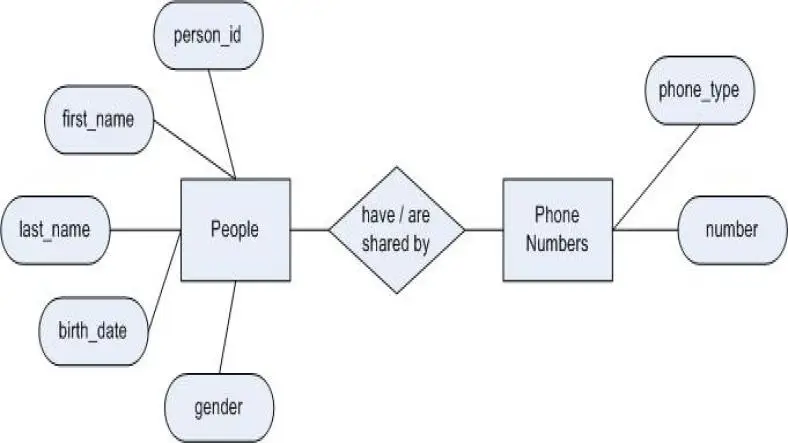Database design is a critical phase in creating a robust, scalable and efficient database system. It involves structuring data in a way that ensures it can be stored, retrieved and managed effectively. Some key concepts fundamental to database design are Normalization, Relationships and Entity-Relationship (ER) Diagrams.
Let's explore these concepts in detail.
1. Normalization
Normalization is the process of organizing data in a database to reduce redundancy and ensure data integrity. The goal is to break down large tables into smaller, related tables, while maintaining consistency across the database.
Normalization is performed in multiple stages, known as normal forms. Each normal form addresses a specific type of anomaly or redundancy.
Here are the first three, which are most commonly used:
- First Normal Form (1NF): Ensures that all table columns contain atomic (indivisible) values and each record is unique.
- Second Normal Form (2NF): Builds on 1NF by ensuring that all non-key columns are fully dependent on the primary key. This removes partial dependencies, where a non-key column depends on only part of a composite primary key.
- Third Normal Form (3NF): Eliminates transitive dependencies, meaning non-key attributes must depend only on the primary key and not on other non-key attributes.
Normalization helps ensure efficient storage, improves query performance and enhances data integrity by eliminating redundancy and anomalies such as update, insert, or delete inconsistencies.
Example: Consider a table storing student information
- Before Normalization:
- StudentID, Name, Courses (Math, Science)
- After Normalization:
- Students: StudentID, Name
- Courses: CourseID, CourseName
- Enrollments: StudentID, CourseID
2. Relationships
In database design, relationships define how tables (entities) interact with each other. They help to establish the logical connections between different data sets.
There are three main types of relationships:
1. One-to-One (1:1):
Google Ad 1
- Each row in Table A is related to a single row in Table B and vice versa.
- This is useful when you want to split data into different tables for security or logical organization.
- Example:
- A person and their passport details might have a one-to-one relationship because each person can have only one passport.
- Table 1 (Person): Stores personal information such as name, date of birth, etc.
- PersonID | Name | DateOfBirth
- 1 | John | 1990-02-01
- Table 2 (Passport): Stores passport information for people.
- PersonID | PassportNumber | IssuedDate
- 1 | X12345 | 2015-01-01
2. One-to-Many (1):
- A single row in Table A can be associated with multiple rows in Table B, but each row in Table B relates to only one row in Table A.
- Example:
- A customer and their orders. One customer can place many orders, but each order is tied to only one customer.
- Table 1 (Customer): Contains customer data.
- CustomerID | CustomerName
- 1 | Alice
- Table 2 (Order): Stores customer orders, where multiple orders can belong to a single customer.
- OrderID | OrderDate | CustomerID
- 101 | 2024-10-14| 1
- 102 | 2024-10-15| 1
3. Many-to-Many (M):
- Rows in Table A can have multiple related rows in Table B and rows in Table B can have multiple related rows in Table A.
- This relationship usually requires a junction table (also called a bridge table) to effectively manage the connections.
- Example:
- A student can enroll in many courses and a course can have many students. A junction table is used to store this relationship.
- Table 1 (Student): Stores student information.
- StudentID | StudentName
- 1 | Jack
- 2 | Sarah
- Table 2 (Course): Stores course information.
- CourseID | CourseName
- 101 | Math
- 102 | Science
- Junction Table (StudentCourse): Manages the many-to-many relationship between students and courses.
- StudentID | CourseID
- 1 | 101
- 1 | 102
- 2 | 101
3. Entity-Relationship (ER) Diagrams
Entity-Relationship Diagrams (ERDs) are graphical representations of entities and their relationships within a database. ERDs help visualize the structure of the database and the interactions between different data entities. They are essential in the conceptual design phase of database modeling.
- Entities:
- Represent the objects or concepts in the database, such as Customers, Orders, Products, etc.
- Entities are usually represented as rectangles in an ER diagram.
- Attributes:
- These are the properties or details about the entities.
- For example, a Customer entity might have attributes like CustomerID, Name and Email.
- Primary Key:
- Each entity typically has a primary key, a unique identifier for the records in that entity.
- For instance, a CustomerID would uniquely identify each customer in the Customer table.
- Relationships:
- Relationships between entities are depicted with lines connecting them, often labeled with the type of relationship (1:1, 1, or M).
Components of ER Diagrams:
- Entities: Objects or things (e.g., Student, Course).
- Attributes: Properties of entities (e.g., StudentID, Name).
- Relationships: Connections between entities (e.g., Enrolls, Teaches).
Example ER Diagram
- Entities: Student, Course
- Attributes for Student: StudentID (Primary Key), Name
- Attributes for Course: CourseID (Primary Key), CourseName
- Relationship: Enrolls (with a many-to-many relationship between Students and Courses, requiring an Enrollments table)
The Importance of Database Design
A well-designed database offers several key advantages:
- Data Integrity and Accuracy: By normalizing the data and ensuring proper relationships, you can avoid redundancy and anomalies, leading to more accurate and reliable data.
- Efficiency: Breaking data into smaller tables and minimizing redundancy allows for faster querying, indexing and updating processes.
- Scalability: A normalized and well-organized database design can more easily accommodate new data or growing datasets, ensuring the system remains scalable.
Summary
Understanding these concepts is essential for creating efficient, scalable and maintainable databases.
- Normalization helps eliminate redundancy.
- Relationships define how tables are linked.
- ER Diagrams provide a visual representation of the database structure.
The fundamentals of database design—normalization, relationships and ER diagrams—are essential to building efficient, scalable and maintainable databases. Normalization reduces redundancy and enhances data integrity, relationships define how tables interact with one another and ER diagrams provide a visual framework for understanding these interactions. Mastering these concepts is critical for any database administrator or developer looking to build robust data systems.
With a well-structured database, you not only ensure better performance but also lay the foundation for a system that can grow and evolve with your needs.















